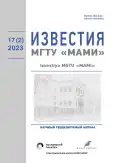Ways to improve performance of an internal combustion engine regarding the loading conditions of vehicle transmission
- Authors: Berdnikov A.A.1, Shangutov A.O.1, Shilonosov A.V.1
-
Affiliations:
- Perm Military Institute of the National Guard Troops of the Russian Federation
- Issue: Vol 17, No 2 (2023)
- Pages: 97-106
- Section: Heat engines
- URL: https://journals.rcsi.science/2074-0530/article/view/253966
- DOI: https://doi.org/10.17816/2074-0530-334351
- ID: 253966
Cite item
Full Text
Abstract
BACKGROUND: Import substitution has become the most important direction of the development of the country's economy in the conditions of the sanctions policy. In this regard, high requirements are imposed on the production to ensure the competitiveness of automotive machinery. Automotive machinery is a key component of the country's economy that is confirmed by the growth of road transport. Meanwhile, growth of the vehicle fleet leads to increase in consuming of petroleum-derived fuel, which main disadvantage is emission of harmful substances, therefore, internal combustion engines of automotive machinery should ensure low fuel consumption and less emissions of harmful substances with exhaust gases. However, the engine operating modes largely depend on the loads generated in the vehicle transmission.
AIMS: To determine the possibilities of expanding the ranges of power regulation of an internal combustion engine of a vehicle, on the one hand, ensuring low fuel consumption and less emission of harmful substances with exhaust gases, and on the other hand, providing with the power required for a vehicle to move, regarding the type of transmission and propulsion.
METHODS: The analysis of possible conventional and unconventional operating cycles of an internal combustion engine is carried out. The method of mathematical modeling of the formation of torques in various types of vehicle transmission is used.
RESULTS: Possible ways of expanding the ranges of power regulation of an internal combustion engine providing with the required power, low fuel consumption and less emission of harmful substances with exhaust gases, as well as transmission layouts and processes of forming the required power in them to ensure the vehicle movement are considered.
CONCLUSIONS: The considered in the article approach of expanding the ranges of power regulation of an internal combustion engine of a vehicle makes it possible to conclude that it is necessary to use the principles of a scientific approach to the process of development of vehicle transmissions capable of controlling an internal combustion engine depending on loads, ensuring its operation with minimal fuel consumption and emission of harmful substances.
Full Text
##article.viewOnOriginalSite##About the authors
Alexey A. Berdnikov
Perm Military Institute of the National Guard Troops of the Russian Federation
Author for correspondence.
Email: aa-berdnikov@mail.ru
ORCID iD: 0000-0003-1716-6659
SPIN-code: 1472-8701
Professor of the of Engineering Support of Service and Combat Activities of the National Guard Troops Department
Russian Federation, 1 Gremyachy Log street, 614030 PermAnton O. Shangutov
Perm Military Institute of the National Guard Troops of the Russian Federation
Email: army_5559@mail.ru
ORCID iD: 0000-0001-7054-8109
SPIN-code: 2737-5382
Associate Professor, Dr. Sci. (Mil.), Associate Professor of the Department of Food and Clothing Supply
Russian Federation, 1 Gremyachy Log street, 614030 PermArtem V. Shilonosov
Perm Military Institute of the National Guard Troops of the Russian Federation
Email: artemjch@rambler.ru
ORCID iD: 0009-0000-2513-5444
SPIN-code: 3760-6350
Associate Professor of the Department of Computer Engineering Software and Automated Systems
Russian Federation, 1 Gremyachy Log street, 614030 PermReferences
- Vyrubov DN, Ivashchenko NA, Ivin VI, et al. Internal combustion engines. Theory of reciprocating and combined engines: A textbook for higher educational institutions in the specialty "Internal combustion engines". Moscow: Mashinostroenie; 1983. (in Russ.)
- Berdnikov AA, Mingazov SR, Zhukov AA. Increasing the economic performance of internal combustion engines by turning off part of the cylinders. Sovremennye naukoemkie tekhnologii. 2017;1:12–16. (in Russ.)
- Berdnikov AA, Nagaitsev DS, Titkov NV. Internal combustion engine with non-traditional duty cycle. Fundamentalnye issledovaniya. 2017;1:21–25. (in Russ.)
- Ter-Mkrtichyan GG. Internal combustion engines with non-traditional work cycles: textbook. allowance. Moscow: MADI; 2015. (in Russ.)
- Five-stroke engine works and can go into production [internet] Accessed: 10.04.23. Available from: http://autoutro.ru/review/2014/11/19/pyatitaktnyj-dvigatel-rabotayet-i-mozhet-pojti-v-proizvodstvo
- SCUDERI™ Split-Cycle Engine – a fundamentally new scheme of a four-stroke motor with a "separate cycle" [internet] Accessed: 10.04.23. Available from: http://enginepro.ru/?p=698
- Berdnikov AA. Evaluation of the mobility of active road trains. Perm: Izd-vo PVI voysk natsionalnoy gvardii; 2022. (in Russ.)
- Belousov BN, Popov SD. Wheeled vehicles of extra large payload capacity. Design. Theory. Calculation. Moscow: MGTU im NE Baumana; 2006. (in Russ.)
- Belousov BN, Shukhman SB. Applied mechanics of ground traction vehicles with mechatronic systems: monograph. Moscow: Agrokonsalt; 2013. (in Russ.)
- Ushnurtsev SV, Keller AV. General provisions for optimizing power distribution in the transmission of military vehicles. Strategicheskaya stabilnost. 2022;2(99):57–64. (in Russ.)
- Lyandenburgsky VV, Shaikhov RF, Ponomarev VM, et al. Fundamentals of car design: chassis, transmission: textbook. Penza: Izd-vo PGAUS; 2014. (in Russ.)
Supplementary files














